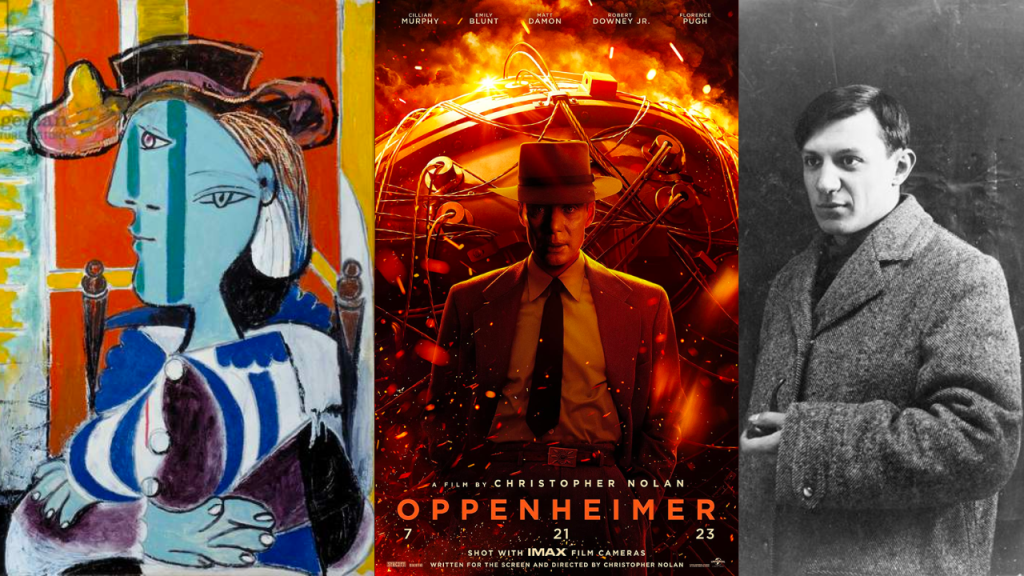In Christopher Nolan’s latest film, “Oppenheimer,” the renowned artist Pablo Picasso makes a star appearance alongside the famed physicist J. Robert Oppenheimer. The movie delves into Oppenheimer’s life, exploring both his scientific brilliance and personal complexities, while also drawing intriguing connections to Picasso’s work. Among these connections is a significant moment in the film where Oppenheimer encounters Picasso’s painting “Woman Sitting with Crossed Arms” (1937) at the Musée Picasso in Paris.

The Film’s Artistic Allusions
Early in the movie, Cillian Murphy brilliantly portrays Oppenheimer as a young physicist in training, meeting the legendary scientist Niels Bohr. As the camera pans down to an unnamed museum, viewers are treated to the enchanting sight of Picasso’s masterpiece, “Woman Sitting with Crossed Arms.” This painting is one of Picasso’s depictions of Marie-Thérèse Walter, a woman he had a romantic relationship with when he was 45 and she was 17.
Picasso’s portrayal of Walter in this artwork is notably abstract, with distorted features that have sparked debates about the artist’s attitude toward women. Some view these portraits as examples of formalist experimentation, while others interpret them as reflective of Picasso’s troubled relationships with women. Interestingly, the film “Oppenheimer” seems to align with the formalist interpretation, positioning the painting amid sparks of light and blue swirls, symbolising life moving into abstraction, much like Oppenheimer’s thoughts on the atomic bomb.
Picasso and Oppenheimer: Flawed Geniuses
While the film appears to celebrate the genius of both Picasso and Oppenheimer, it also delves into their personal flaws. Picasso’s history of questionable behavior towards women and Oppenheimer’s philandering tendencies are both explored, adding layers of complexity to their portrayals. Thus, Oppenheimer’s appreciation for “Woman Sitting with Crossed Arms” may not be as straightforward as initially perceived.
A Hidden Biographical Detail
Interestingly, the film omits a small biographical detail from the book on which it is based, “American Prometheus: The Triumph and Tragedy of J. Robert Oppenheimer” by Kai Bird and Martin J. Sherwin. The authors reveal that Oppenheimer’s parents maintained an art collection in their home during his childhood. Alongside renowned artists like Rembrandt and Renoir, the family reportedly possessed a Blue Period Picasso painting titled “Mother and Child” (1901). This revelation hints at the possibility that the young Oppenheimer was exposed to Picasso’s art early in his life, potentially influencing his later appreciation for the artist’s work.
The Intersection of Picasso’s Art and Science
Beyond the personal connections, some scholars have drawn parallels between Picasso’s art and developments in physics. In 2002, Arthur I. Miller authored a book comparing the biographies of Picasso and Albert Einstein, another prominent figure in Oppenheimer’s life. Interestingly, a quote by Gertrude Stein about Picasso’s perception could equally apply to Einstein and Oppenheimer: “The things that Picasso could see were the things which had their own reality, a reality not of things seen but of things that exist.”
As “Oppenheimer” unfolds on the big screen, it weaves together the lives of two brilliant yet flawed figures, J. Robert Oppenheimer and Pablo Picasso. The encounter with Picasso’s iconic painting offers a thought-provoking moment in the film, highlighting the intersections between art and science, and the complexities of human nature.
The Legacy of Barbie: Its been 64 Years, How Is She Still Relevant?

Contributor





